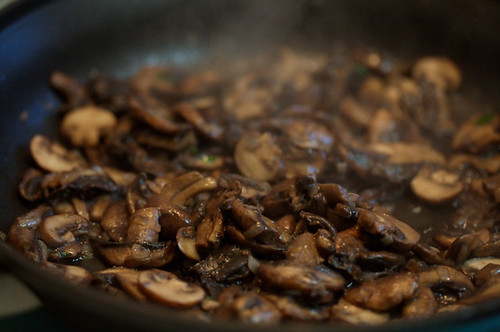(Part of The Cookbook)
With one exception, you don't create flavors when you make a dish. What you do is simply arrange foods and seasonings together so they complement each other and taste good, but the flavors in those foods are created by nature. I know you're with me so far.
The one thing you can do in the kitchen to add flavor is to brown a food item with heat. Browning changes the way a food tastes drastically. Think about the flavor of mushrooms simmered to doneness in a soup compared to mushrooms roasted crispy in a hot oven. Browning makes such a difference that it splits the whole world of cooking methods into three categories: wet cooking where no browning occurs, dry cooking where browning does occur, and combination cooking methods, where both wet and dry cooking takes place.
Wet cooking involves water somehow. Since water evaporates at 212 deg. F. and browning occurs between around 300 and 360 deg. F, you'll never get browning using a wet cooking method.
By understanding the nature of the cooking method you're thinking about using, you can more accurately predict what your result will be.
Wet cooking methods:
Boiling/simmering/poaching - immersion in hot, water-based liquid of varying temperature ranges
Steaming - contact with steam from some source of boiling water
Dry cooking methods:
Sauteeing - high heat, a little bit of fat in a shallow pan
Frying - high heat immersion in fat
Roasting/Broiling - contact with hot air (roasting) or proximity to a nearby object that radiates heat (broiling)
Baking - contact with hot air
Grilling - contact with heated metal and proximity to a nearby heat source
Combination cooking methods:
Braising/stewing - browning of large items (braising) or small items (stewing), then immersion in water-based liquid
For examples, you can find a list of recipes grouped by the above cooking methods here (scroll down to the "Browse by cooking method" section).
Why do I keep using the weird term "water-based liquid?" Well, oil's a liquid too, but it has nothing to do with wet cooking because it's not water.
There's another method that doesn't quite fit in the above categories. Sweating is low-heat sauteeing, and as a result, it doesn't brown food very much. It actually creates a steaming effect by gently bringing out the water in foods as steam. So, it's a kind of weird method. I like it, though. It's gentle and subtle.
In most cases, I think browning an item to develop flavors is a good idea and I do it a lot, even if I'm just going to add it to a soup later. If you put a little color on your onions by sauteeing them for a couple of minutes and then add them to your simmering stock, they'll add both the basic onion flavor and the rich, mellow, complex flavor of browned onion.
Given the choice of getting more or less flavor from something you paid for, which would you choose?



No comments:
Post a Comment